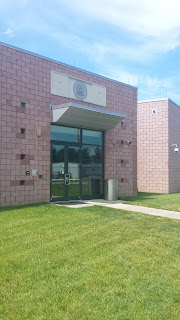Another "show and tell" (see last week's post if you don't know what that is) this week gave me the amazing opportunity to work with the Library's Core Collection. The collection consists of documents, sketches, letters and photographs that are historically significant and fairly recognizable for anyone who's taken Fourth grade American History. The collection is housed in plastic and card stock cases that allow them to be moved and touched without much damage - which makes them easy to pull out when we find out that a group of congressional interns are coming in less than two hours and want to see some "cool" stuff. (Apparently, according to my boss, it's not that infrequent that they are asked to provide a show and tell on super short notice.)
So some of the materials that we specifically chose for this group of interns was a letter written by Jackie Kennedy to her wedding photographer, Alexander Graham Bell's first sketch of the telephone, a letter written by Lincoln to a subordinate in the army about African Americans receiving the same widow's rights as white women, and a petition written around 1692 by a group of women accused of witchcraft in Ipswich, asking for bail. The whole collection is digitized so anyone can look at these online (here's the address: http://memory.loc.gov/ammem/mcchtml/corhome.html) but I always think there's an awe-inspiring aspect of being able to see the tangible object in its original form.
Also part of the show and tell - something I didn't even know we had in the Manuscript Division - was a collection of three separate locks of Thomas Jefferson's hair. My first reaction, and some of my family's, was more disgust than interest, but historically, people would cut locks of hair from their loved ones after they passed away as something to save as a memento. I didn't find it particularly appealing, however the interns all found it exciting to see.
On Friday, the Junior Fellows had the unique option to go on a tour of the high-efficiency storage facility the library has in Fort Meade, MD. As you can see from the pictures below, the warehouses are huge, but even more impressive is the engineering innovations that help to conserve the materials stored there. For example, the warehouses are kept at 50 degrees Fahrenheit with about 30% humidity - needless to say, we were all a bit chilly when I took these photos. Also, there's another "cold" storage area specifically for microfilm that is housed at 35 degrees Fahrenheit with 30% humidity. In order to get a microfilm reel from the cold storage area, it has to be left in a 50 degree staging area for 48 hours to minimize the condensation damage when it gets transported to the library.
The process of shelving the materials is also rather unusual but effective: books are stored according to size and not subject. This way, storage shelves can be designed to match a specific height and leave more room for more books. In order to prevent mass confusion, each book is bar-coded and then placed in a box with other similarly sized books, which in itself is also bar-coded and then placed on a specific shelf location, which, surprise, is also bar-coded. Then all these bar codes are linked to that one book so when the request comes in from the Library, finding the book on the shelf is a short task.
When I go on field trips like this, I am amazed at how all the storage facilities, reading rooms and different divisions work together to form the largest library in the world. I am a small part of what happens in the Library, and yet, what I do is just as important as the archivists, conservators and historians. It is a truly incredible place to be a part of - and I'm really loving every minute of it.
 |
| The preparation area, where materials get cleaned and ready to go on the shelf |
 |
| A view of one of the rows of stacks. The shelving goes 30 ft up and there are multiple rows per store room. |
 |
| The forklift they have to use to get materials down from the upper shelves. |
 |
| A view looking down to another store room, there are 3 in total with plans to build more. |
 |
| The front of the building - very ordinary for a not-so-ordinary facility. |
No comments:
Post a Comment